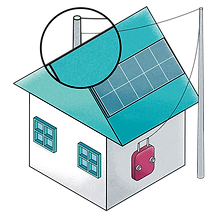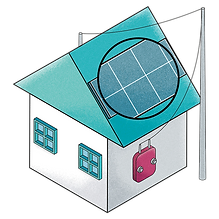
None of us know for sure what the future will look like — but we can expect smart buildings to be an essential part of it. At least 75% of participants appear to be Deloitte study To think about: In the next five years Would smart buildings become the norm become — and when you take a look at the potential of these, you also understand why.
The newfangled term for smart homes refers to buildings that have digitally networked infrastructures. These integrate information, operation, control applications, materials and construction as an entire construction system. This can include smart homes (living spaces) as well as functional buildings — such as smart factories (production buildings) or smart offices (office space) — which are equipped with intelligent solutions. Smart buildings make context-based decisions based on data collected via digitally networked infrastructures for private and overall societal benefits. According to Deloitte, it is hoped that smart system and data integration will result in increased user satisfaction, energy efficiency and cost and risk reductions, among other things.

Smart buildings therefore not only offer advantages for private individuals, for example in the form of technical convenience, for example through forecasted maintenance based on available data, but the environment can also benefit from this through digital interconnectivity in terms of optimized energy efficiency, reduced CO2 emissions and much more!
Smart buildings are buildings that integrate and take into account information, operation, control applications, materials and construction as an entire construction system. Adaptability rather than reactivity is key to this in order to meet basic conditions for continued construction: energy efficiency, durability, and personal comfort and satisfaction.
Of course, this all sounds very technical and headache-causing, but as a result, it is much easier to understand than you should initially assume.
As I said, smart buildings use collected data to make adjustments based on it — for the users of the building itself, or for the larger infrastructure to which the building belongs. For example, let's say it's winter and the building finds that its residents are suddenly heating far more. Is there a correlation here? Most likely — a process which can therefore be adopted automatically.
Or why not track lamp usage within the household and adapt the lights to the corresponding needs of users? A process which, for example, has the positive side effect of optimizing energy use and thus consumption of up to 30% and probably to lower more. The wallet definitely thanks you.
Potential or not, one or the other person may now naturally be creeped at the thought of living in a house that receives this level of input and control. After all, that works a bit Orwell and that is an aspect that is definitely debatable. Analog intervention options are therefore essential and are also in the interest of an appropriate smart building — not least because of resulting security issues, but also the previously mentioned aspects of comfort, satisfaction and the like.
After all, comfort and satisfaction are how Buckman et al. Identify very vague terms that are not to be understood one-dimensionally, but multiple and diverse. Interpretations of the term range from “sitting comfortably in front of the fire with a glass of red wine” to “May my weighted blanket flatten me until I fit under the gap in my bedroom door.” Ideally, smart buildings should therefore not restrict these subjective definitions of terms. That is why a list can be likes and Dislikes Identify, when it comes to smart buildings, which corresponding regulatory options entail.
User Likes 👍
User Dislikes 👎
It can therefore be stated for private use: A good smart building is user-friendly and reliable, but that's not all, of course. What else do intelligent new buildings have to offer?
It is clear that smart buildings are equipped with a variety of interesting technologies. We would like to introduce you to the most exciting and typical ones.
Overall, a small, fine, digital work chain.

Smart metering — A network of intelligent objects, for example in the form of meters and the sensors just mentioned, which can be used to measure and control building technology systems. With the help of smart metering, users can better understand their own consumption and contribute to higher energy efficiency using the resulting data.

Smart grids — Intelligent power grids that control and connect power producers, electricity consumers and storage systems, including the previously mentioned smart metering.
This creates a data and energy network that enables new structures and functionalities.

Sustainable energy sources — Whether solar panels or the like, smart buildings usually generate their electricity in an environmentally friendly way, which further accommodates the already economical optimization of electricity.
Building Information Modeling — Or abbreviated: BIM, the digital modelling of buildings to optimize the planning of building construction and construction. In this way, you can finally create order and put an end to paper chaos in the office.
Clearly, the capabilities and skills of smart buildings are very impressive — and the ultimate goals they are given are certainly commendable. Because a good smart building is not only user-friendly and satisfying, it is also reliable, routine, resource and energy efficient and, of course, sustainable.
It therefore seems absolutely inevitable that we will see more and more smart buildings in the future — the potential of these is simply too promising, as we think. However, it remains to be seen whether this will happen in the next five years. Because despite the new digital opportunities, one thing currently seems to be missing: The standard for implementing smart building technologies.
Accordingly, we regularly discuss the topic of “Build Smart or Smart Building? ”. Would you like to be part of it? Then follow us on LinkedIn and keep your eyes and ears open — like a smart sensor — for the next round and an invitation to our “Let's Talk Real Estate” roundtable format! We are looking forward to the discussion with you!
For further reading:
Du hast eine Frage oder möchtest herausfinden, wie wir zusammenarbeiten können?
Melde dich gerne hier oder über LinkedIn bei uns – wir freuen uns, von dir zu hören